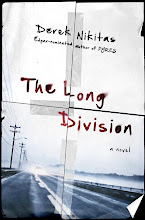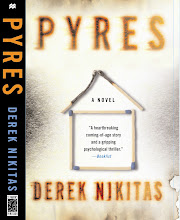I like a look of Agony,
Because I know it’s true—
Men do not sham Convulsion,
Nor simulate—a Throe—
The eyes glaze once—and that is Death—
Impossible to feign
The beads upon to Forehead
By homely Anguish strung.
—Emily Dickinson
I teach college. Lit, writing, movies. I don’t teach schlock, so I’ve done my fair share of defending what I teach against students who’d rather not have what I’m teaching taught to them. It doesn’t burn me out, this tireless defending. I thrive on it. I thrive because every semester a handful of students get it. As for the rest: I tried, so, hey, shove off.
I’d be here all night if I listed what sorts of arts I defend against the forces of kitsch and mediocrity. I’m not saying I don’t fall prey in my own writing. Mediocrity is seductive, especially when you’re burnt out and over deadline. I’m talking here about the books and stories and movies I teach. Students hate surrealism, for instance. When did that start?
Gen-Xers loved the surreal. We watched MTV when it still played videos, almost all surreal. We watched Ren And Stimpy. We grew up on Twin Peaks and listened to They Might Be Giants. Natural Born Killers and David Lynch movies. Maybe it’s just me and my friends I mean. Shit didn’t have to make sense. These kids, they call it “random” and dismiss it. No logical sense equals no value. One wonders what these kids think when they see SpongBob Squarepants or almost all the shows on Adult Swim. I got a lecture on the virtue of surrealism, but I’ll save it.
I’m more concerned with Melancholy. Not concerned with the word’s literal meaning, just its sense in art. Melancholy is a basic human need. A defense mechanism. In this age of self-help and The Secret, of born-again Christianity and depression medication, Melancholy is in danger of going extinct. Fine: Melancholy won’t go extinct as long as there are humans to brood, but I fear it’s losing its respect as a viable mood. Melancholy in my book: the artful shaping of depression, sadness, pessimism, loneliness, spiritual doubt and all other quietly negative moods so as to give a positive charge.
Think most of Ingmar Bergman or Lars von Trier’s films. Think Wes Anderson and Woody Allen’s brand of cinematic humor (when they’re at their best). Think P.T. Anderson in Magnolia and Punch Drunk Love. Think nearly every great writer in the history of English, but especially Thomas Hardy, Dickens at his gloomiest, Emily Dickinson and Shakespeare in his sonnets and in Hamlet. Some of the great noir writers, like Horace McCoy in They Shoot Horses, Don’t They? or Dave Goodis in Down There (i.e., Shoot the Piano Player) have built whole worlds out of Melancholy. Heck, noir’s another word for the same thing, ain’t it?
Think Edvard Munch’s or Edward Hopper’s paintings. Think all the great shoe-gazer bands of the last twenty years, like Joy Division, The Smiths, The Cure, Bright Eyes, Radiohead, Coldplay, Interpol, The Eels—too many to list.
Literary graphic novels have a corner of the Melancholy market. Ex: Jimmy Corrigan: The Smartest Kid on Earth, Persepolis, American Splendor, and Fun Home. Seems almost paradoxical, the medium made for bright flexing action heroes could be so still, silent, contemplative. But one page of Chris Ware’s work will convince you that “comic” panels were custom-made for Melancholy.
I have trouble getting students to accept that Melancholy is a beneficial emotion, that aesthetic brooding is a worthwhile pastime. But if not for Melancholy, I’d be depressed. When confronted with Melancholy, some people say, “This is depressing,” a statement meant for dismissal, for banishment. Luckily, they listen to reason if you reason well enough. Melancholy is about emotion but sometimes it takes reason to get there, a new perspective on what art is for. I’ve actually convinced people born after 1985 to enjoy Bergman’s Persona and von Trier’s Breaking the Waves.
Good Melancholic art takes the raw formless blue of depression and molds it into something beautiful. We have words for depression that imply nothingness, shapelessness: dark, gloom, dumps. But Melancholy shapes depression the way meter shapes raw language into verse, the way novels and movies shape raw experience into pleasurable structure, the way musical notes shape noise into song. In fact, Melancholy uses these very techniques to help shed light on the darkness of a foul mood.
The Dickinson poem at the start of this post. Her hymnal meter helps shape the dark sentiment, as does her unique view, the truth at which she arrives. She takes charge of ugliness and gives it beauty, tells us she “likes” a look of agony and we believe her. We like it too, when we see it through her lens. Melancholy still has the power to shock us, not with extravagance or spectacle, but with epiphany. Our dark emotions we keep private because we think they’re our personal burden, until Melancholy art holds up a mirror and calls it truth.
When Hollywood movies and pop songs and bestseller books tend to press experience into saccharine little cakes (Eat, Pray, Love, for instance), the right kind of Melancholy art is a cool blast against our overheated culture. It helps fortify us against the forces of blind conformity, blind faith, medicated numbness and cultural superficiality. What is temporarily satisfying and “escapist” has rarely ever felt authentic.
The virtue of Melancholy is not that it heals us, because we can’t be healed—not unless we want to stop feeling altogether. Melancholy teaches us how the bear the pain, how to make it drive us in our thoughts and experiences. This is what all good art does, I guess. Happy endings cheat us out of that possibility much too often.
I’ll admit Melancholy doesn’t work for everybody. Those who are truly, medically depressed have pain too strong for art to shape. Same with those who’ve seen real trauma, especially if it’s recent. On the other hand, if you’ve lived a Disney fantasy your whole life, your sense of truth will always be skewed, even a little deadened. God help you when the pain arrives. But the rest of us, I think, can benefit from a vitalizing walk in the gloaming every now and then.



2 comments:
I could never get past "Democritus to the Reader," to be honest. And the only reason I picked it up in the first place was because it had an intro by William H. Gass and because it was mentioned in a book (the vastly underrated Been Down So Long Looks Like Up To Me, by the folksy Richard Farina) with an introduction by Thomas Pynchon. But since it was your title, I have to ask: did you ever make it through the two or three thousand page behemoth? If 'yes', I've got to buy you a drink someday.
(Also, have you been keeping up with Chris Ware's Acme Novelty Library? The melancholy is still going strong in his new Rusty saga.)
Hey, Matthew! No, I never read any more of Burton's book/encyclopedia than what was anthologized in the Renaissance survey class I took as an undergraduate--all of five pages of it, though I do remember the fun stuff about the humors, bile and blood and all. The allusion in the title is an empty one; I just like the sound of it. So, apparently, did Burton, since Anatomy of Melancholy turns out not to be much about melancholy at all.
I'll check out Acme Novelty Library.
Post a Comment